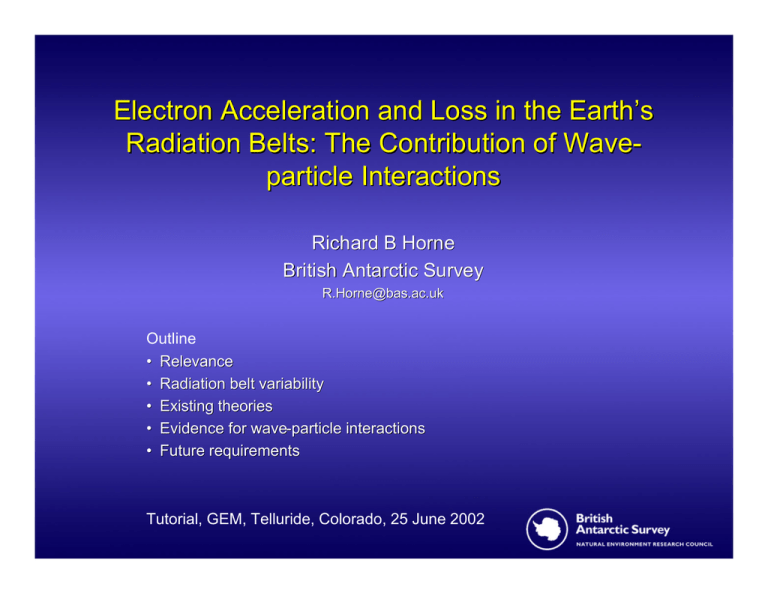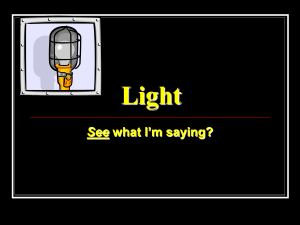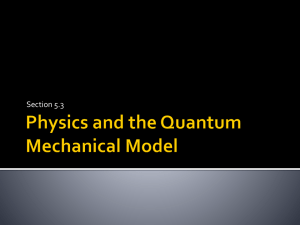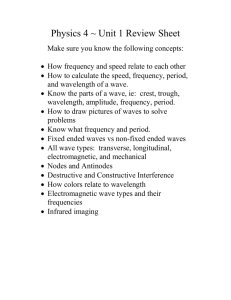Electron Acceleration and Loss in the Earth’ s -
advertisement

Electron Acceleration and Loss in the Earth’ s Radiation Belts: The Contribution of Waveparticle Interactions Richard B Horne British Antarctic Survey R.Horne@bas.ac.uk Outline • Relevance • Radiation belt variability • Existing theories • Evidence for wave-particle interactions • Future requirements Tutorial, GEM, Telluride, Colorado, 25 June 2002 Earth’ s Radiation Belts • Discovered in 1958 by James van Allen and his team Iowa • Trapped electrons and ions • Only one proton belt – 0.1 - several 100 MeV – Peak near L = 1.8 • Two electron belts with slot region in between – For E > 1MeV peaks near 1.6 and 4.0 Re • Outer belt highly variable cf inner belt • Outer belt extends to geostationary orbit • Hazardous to astronauts and spacecraft • From Meredith et al. [2002] • (red = 1.47 MeV) Relevance • Radiation environment damages spacecraft – MeV electrons cause internal charging – 0.1 – 100 keV cause surface charging – MeV ions cause single event upsets – Cumulative radiation dose • Degradation of performance • Swelling of mirror surfaces • Darkening of glassy surfaces • Solar cell degradation • Thermal control degradation • Damage electronic components • Limits lifetime • ESA study 2001 – 3 out of 4 satellite designers said that internal charging is now their most important problem [Horne, 2001] • MeV electrons Wrenn and Smith [1996] Satellite Losses • Internal charging and ESD is related to MeV electron flux (variations) – more than 20 spacecraft damaged [Wrenn and Smith, 1996] • Several examples of spacecraft damaged during storms when flux was enhanced, e.g., Baker et al. [1998] – 1994: Intelsat K, Anik E1, & E2 – 1997: Telstar 401 – 1998: Galaxy IV – But whether space weather was the direct cause is controversial • US National Security Space Architect: – 13 satellites lost in 16 years that can be attributed clearly to Space Weather Cost Estimates • Modern telecommunications spacecraft – To build ~ US$200M – To launch to GEO ~ $100M – To insure each year ~ 3-5% • About 600 spacecraft launched • About 250 spacecraft in GEO – about 100 insured • Substantial losses to space insurance – 1998: Loss claims $1.6B premiums $850M – 2000: Loss claims $1.0B premiums $xx • Space weather cause or contributor to $500M of loss 1994-97 (US insurance brokers) • Overall risk is becoming higher: – All space claims: 1989 $200M, – All space claims: 1998 $1.65B Future Growth Area • Telecommunications is a growth area – From $20B – to $100B over next 10 years (UK House of Commons, 2000) • Internet, direct TV, navigation • EU – Galileo project 2005-2008 – 30 spacecraft – L = 4.7 and GEO • US – next generation GPS • New technology – new risk • Research on radiation belts is relevant – satellite design and construction – launch operators – service providers – space insurance Outer Belt Variability Li et al. [1997] Electron Flux During Magnetic Storms • Kim and Chan, [1997] • MeV flux drops rapidly at storm main phase (as measured by Dst) • Flux increases during recovery phase • Flux increases above pre-storm level before Dst recovered • Net acceleration • How are electrons accelerated? Variations in Flux at Geostationary During a CME Event • Jan 1997 storm CME event [Reeves et al.,1998] • Rapid variations on periods of hours • Net increase MeV electrons above prestorm level over 2-3 days • 2 timescales Magnetic Storm Association • 90% of magnetic storms associated with flux enhancements Reeves [1998] • Now 50% ! • Why don’ t all storms result in acceleration ? • Some storms result in net loss of electrons Fast Solar Wind Streams • Flux enhancements correlated with fast solar wind streams, e.g., Paulikas and Blake [1979] , Baker et al. [1997]; Buhler et al. [1997] Summary of Observations • Electron enhancements in the radiation belts are correlated with: – Fast solar wind streams [Paulikas and Blake, 1979]. – CME events [Li et al., 1993]. – IMF Bz < 0 [Blake et al., 1997]. – Magnetic storms [Baker et al., 1986; Reeves, 1998]. • During a magnetic storm, typically: – Electron flux rapidly decreases at the beginning of the main phase. – Flux increases above pre-storm levels 2 -3 days after the main phase. • Not all magnetic storms or fast solar wind streams result in enhanced electron flux. • Acceleration must be internal to the magnetosphere – Li et al. [1997] • How are the electrons accelerated ? • Where are they accelerated ? • How much loss ? Adiabatic Invariants • Particles trapped by magnetic field • Conservation of all 3 invariants results in flux changes – but no net acceleration or loss • Flux observed above pre-storm level before Dst recovered • Acceleration requires breaking 1 or more invariants – E, B fields at frequencies comparable to drift, bounce and cyclotron frequencies Accelerations Mechanisms • Inward radial diffusion – [Schulz and Lanzerotti, 1974] • Re-circulation model – [Nishida, 1976; Fujimoto and Nishida, 1990] • Dayside compression (inductive E field) – [Li et al., 1993; Hudson et al., 1997] • ULF enhanced radial diffusion – [Hudson et al., 1999; Elkington et al., 1999] • Wave particle interactions – [Temerin et al., 1994; Li et al., 1997; Horne and Thorne, 1998; Summers et al., 1998] • Cusp trapping and diffusion of energetic electrons – [Sheldon, 1998] • Substorm injection – [Kim et al., 2000; Fok et al., 2001] • ULF and whistler mode waves – [Liu et al., 1999] Radial Diffusion • Schulz and Lanzerotti [1974] • Inward radial diffusion requires: – Spatial gradients in the phase space density – Fluctuations in B and (electrostatic) E fields – Breaks the 3rd adiabatic invariant • Acceleration occurs by inward transport into larger B and conservation of – M = p 2 sin2a/(2m0B) and J • OK for quiet times • Too slow for disturbed times ULF Enhanced Radial Diffusion • Radial diffusion rate enhanced by ULF waves [Hudson et al., 1999; Elkington et al., 1999; Mathie and Mann, 2000] • Pc-3-5 waves observed during electron events • Wave period is comparable to drift period of MeV electrons • Propose electrons are accelerated by drift bounce resonance with toroidal-mode ULF waves • Breaks 3rd invariant, but 1st and 2nd are conserved • Important mechanism Evidence for Radial Diffusion • Hilmer et al. [2000] • Fast solar wind stream and Kp > 3 • Flux increases first at L=6.6, then L = 4.7 • Consistent with inward radial diffusion • Showed that radial diffusion driven by electric field fluctuations was main contributor Problems With Radial Diffusion Brautigam and Albert [2000] • Modelled Oct 1990 storm using CRRES data • Model, Kp dependent, boundary conditions at GEO Concluded: • Radial diffusion underestimates flux by factor at 1000 MeV/G by factor of 5 near L=4 • Peak flux observed near L=4 Problems With Radial Diffusion • Storm times - Important for E < 500 keV, but underestimates the flux at > MeV near L=4 • Direction of diffusion is outward during main phase of storm – Electron deceleration • Peak in phase space density near L=4 suggests local acceleration – Miyoshi et al. [2002], Brautigam and Albert [2000], Selesnick and Blake [2000], McAdams et al. [2001] • Long timescales for inward diffusion to L = 4 – Thorne et al. [2002] Substorm Injection • Acceleration by substorm injection [e.g., Kim et al., 2000; Fok et al., 2001] • But • Injected particles are usually < 500 keV • Substorms may play an important role supplying the seed population Thanks to N. Fox for simulation Contribution of Wave-Particle Interactions • Waves at frequencies that break the 1st invariant (and hence all 3) Evidence for Particle Loss by Waves • Lyons and Thorne [1973] • Quiet time radiation belts • Balance of inward radial diffusion with losses due to whistler mode hiss • High density region • Agrees well with observed radiation belt structure • Strong evidence for waveparticle losses by Doppler shifted cyclotron resonance Doppler Shifted Cyclotron Resonance • For resonance with electrons, wave frequency is Doppler shifted by motion along B. • For propagation along B, whistler waves and electrons must propagate in opposite directions • Electric field rotates in same sense as electrons • E field remains in phase with particle • Efficient exchange of energy Resonant Ellipse • In the relativistic case, the resonance condition is an ellipse • The minimum resonant energy (Eres) is where the ellipse crosses the vz axis • To solve - require the phase velocity – obtained from the dispersion relation • Dependence on – Plasma frequency fpe – Gyro-frequency fce – Propagation angle – Wave frequency • For f < fce, Eres smaller for R mode • For f < fci, Eres smaller for L mode Resonant Diffusion Single Wave Characteristics Force on an electron • Gendrin [1981] showed that small amplitude waves diffuse particles along constant energy surfaces For transverse plane waves Transform to wave frame –fields at rest Force is orthogonal to electron displacement – no net transfer of energy In the wave frame the particle energy is conserved Resonant Diffusion Single Wave Characteristics • In the wave frame: • Particles scattered along circles in velocity • Transform back to lab frame: • Single wave characteristics are circles centred on the phase velocity along which the particles are scattered • Can determine pitch angle and energy scattering due to single waves Single Wave Characteristics – Low Phase Velocity • Particle distribution (blue) anisotropic Tp > Tz (red = constant energy) • Particle diffusion along single wave characteristics (black) – To lower phase space density • At Vres, direction must be anti -clockwise • Scattered mainly in pitch angle • Small energy gain or loss for low phase velocity Single Wave Characteristics – High Phase Velocity • Particle distribution (blue) anisotropic Tp > Tz (red = constant energy) • Particle diffusion along single wave characteristics (black) – To lower phase space density • At Vres, direction must be anti -clockwise • Scattered in pitch angle and energy (energy loss) • Contribute to wave growth Single Wave Characteristics – High Phase Velocity • Particle distribution (blue) isotropic Tp = Tz (red = constant energy) • Particle diffusion along single wave characteristics (black) – To lower phase space density • At Vres, direction must be clockwise • Scattered in pitch angle and energy (energy gain) • Contribute to wave damping Broad Band Waves • Single wave characteristics provide insight • Real world – Broad band waves – Overlapping resonances • Quasi-linear diffusion approach – Waves uncorrelated – Small scattering with each wave – Large enough bandwidth – Diffusion is proportional to wave power • Stochastic diffusion Energy Gain by Whistler Mode Waves • Summers et al [1998] • Included bandwidth of waves for resonant diffusion • Assume a bandwidth of resonant waves • Scatter to larger pitch angles (left) also results in energy gain (right) • Energy gain more effective in low density • Whistler and Z mode effective Electron Loss by EMIC Waves • Summers et al [1998] • Electromagnetic ion cyclotron (EMIC) waves • Scatter in pitch angle • Almost no energy gain or loss • Not effective for acceleration • Contribute to electron loss from the radiation belts Acceleration by Doppler Shifted Cyclotron Resonance • Seed population with E ~100 keV provided by substorm injection and inward diffusion – Fast solar wind streams with IMF Bz <0 fluctuations • Waves are generated by unstable electron (or ion) distributions at E ~ 100 keV – Pitch angle scattering and loss of particle energy at low energies – But, energy gain by particles possible at higher energies • As waves propagate the phase velocity changes and the waves resonate with ~ MeV electrons • Electron acceleration takes place, as the waves are absorbed, via Doppler shifted cyclotron resonance • Wave absorption heats the tail distribution function, producing enhanced flux Resonant Energies • Horne and Thorne [1998] • To accelerate electrons waves must be able to resonate with 0.1-few MeV electrons • Found 5 wave modes – Whistler mode – Magnetosonic – Z mode – RXZ – LO • Whistler mode is a prime candidate for acceleration (and loss) • Electromagnetic ion cyclotron waves (EMIC) contribute to loss Loss and Acceleration • • • Waves contribute to loss (EMIC) and acceleration Acceleration (by all mechanisms) must overcome the losses How much loss ? – De-trapping by large scale fields – Wave losses Meredith et al., JGR [2001] Whistler waves enhanced during substorms Oct 1990 storm E=1.09 MeV • High AE activity 214 keV • Electron injection • Enhanced waves 14.3 keV • Electron flux enhancements Lower band Chorus V Solar wind & Bz Dst AE & Kp Spectral Hardening • Meredith et al. [2002] • Requires enhanced level of substorm activity to pump the low energy (< 100 keV) electrons • Spectral hardening near L=4 during the recovery phase • Acceleration is observed to be energy dependent – Consistent with wave acceleration Resonant Pitch Angles • Assume parallel propagation of whistler mode • Dominant n=-1 resonance • Compute resonant ellipse for a band of waves • Compute range of pitch angles for given energy • Wave growth by scattering and loss at low energies • Energisation by scattering of trapped electrons at large pitch angles • Consistent with flat top distributions Timescales • [Summers and Ma [2000] • Developed Fokker Planck equation for evolution of f(v) due to waves • Energy diffusion more effective at lower L • Simulation by Miyoshi et al [2002] – Constant wave amplitude of 50pT – Seed electrons at 30 keV injected – Spectral hardening just outside plasmapause – (a) 300 keV electrons, then (b) 2500 keV – Timescale – 1-2 days Evidence for Doppler Shifted Cyclotron Resonance • Evidence to support: • 5 wave modes can resonate with 0.1 – few MeV electrons • Local acceleration near L=4 – Whistler mode wave amplitudes enhanced just outside plasmapause where electron flux is observed to be enhanced • Whistler wave amplitudes enhanced by repeated substorm injection during storm recovery phase – consistent with acceleration events – consistent with fast solar wind streams and IMFBz < 0 • Pitch angle distributions are flat topped – consistent with pitch angle scattering • Particle spectrum is energy dependent – consistent with limited range of resonant energies Electron Loss • Loss to the magnetopause – Magnetopause can be compressed inside L=6.6 – De-trapping of particles and drift outwards to magnetopause – How much loss ? • Loss to the atmosphere – Pitch angle scattering into the loss cone – Observations of precipitating particles – How much loss ? Evidence for EMIC Waves • Braysy et al [1998] • Evidence for EMIC waves during magnetic storms • Amplitudes enhanced during storm main phase • Driven by injected ring current H+ • Scattering and loss of protons and MeV electrons EMIC Resonant Energies • EMIC wave minimum resonant energies from CRRES (Brian Fraser) • L mode (top) resonates with ~ 1MeV electrons • R mode (bottom) > 1 MeV • Experimental evidence for scattering and contribution to electron loss Summary • Research on the radiation belts is relevant • Electron acceleration has several complex features • Experimental evidence to support several theories – Wave-particle interactions contribute to acceleration and loss • Difficult to exclude any (internal acceleration) theories based on existing analysis Future Needs • Quantify losses – Sets constraints on acceleration required • Need to identify conditions to test theories, e.g., – Location of acceleration – Direction of diffusion – Timescales • Need better models – Magnetic field – Diffusion coefficients – need better measurements • Characterise the seed population – Outer trapping region – radial diffusion – L ~ 4 waves • Need for more observations – ILWS – GPS - Galileo – Multi -point – Combined waves and particles – Ground based References 1 References 2 References 3 References 4 References 5 References 6 References 7



